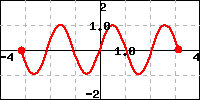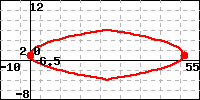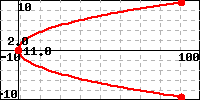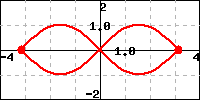Section 2.6 Exercises
These are the exercises in Module 2.
Checkpoint 2.6.1.
Checkpoint 2.6.2.
Checkpoint 2.6.3.
Enter Yes or No in each answer space below to indicate whether the corresponding equation defines \(y\) as a function of \(x\text{.}\)
1. \(x^2y+y= 9\)
2. \(4 x = y^2\)
3. \(4 + x = y^3\)
4. \(x + 4 = y^2\)
Checkpoint 2.6.4.
The domain of the function
\(f(x)=\sqrt{x(x-14)}\)
is
Write the answer in interval notation.
Note: If the answer includes more than one interval, write the intervals seperated by the union symbol, U. If needed end \(-\infty\) as -infinity and \(\infty\) as infinity.
Checkpoint 2.6.5.
Checkpoint 2.6.6.
Checkpoint 2.6.7.
Checkpoint 2.6.8.
Checkpoint 2.6.9.
Select the expression that is equivalent to
\(\frac{x-1}{5x}\cdot\frac{x}{x^2-1}\)
-
\(\displaystyle \frac{-1}{5(x-1)} \)
-
\(\displaystyle \frac{1}{5(x+1)}, x \neq 0, x \neq 1 \)
-
\(\displaystyle \frac{-1}{5(x-1)}, x \neq 0, x \neq 1 \)
-
\(\displaystyle \frac{1}{5(x+1)} \)
-
\(\displaystyle \frac{-1}{5(x-1)}, x \neq 0 \)
-
\(\displaystyle \frac{1}{5(x+1)}, x \neq 0 \)
-
None of the above
Checkpoint 2.6.10.
Write \(\frac{m}{2}+\frac{m}{3}\) as a single fraction.
-
\(\displaystyle \frac{2m}{6} \)
-
\(\displaystyle \frac{m^2}{6} \)
-
\(\displaystyle \frac{5m}{5} \)
-
\(\displaystyle \frac{5m}{6} \)
-
\(\displaystyle \frac{m}{5} \)
-
\(\displaystyle \frac{2m}{5} \)
-
None of the above
Checkpoint 2.6.11.
Select the expression that is equivalent to
\(\frac{x-2}{5x}\cdot\frac{x}{x^2-4}\)
-
\(\displaystyle \frac{-1}{5(x-2)}, x \neq 0 \)
-
\(\displaystyle \frac{1}{5(x+2)}, x \neq 0 \)
-
\(\displaystyle \frac{1}{5(x+2)} \)
-
\(\displaystyle \frac{1}{5(x+2)}, x \neq 0, x \neq 2 \)
-
\(\displaystyle \frac{-1}{5(x-2)}, x \neq 0, x \neq 2 \)
-
\(\displaystyle \frac{-1}{5(x-2)} \)
-
None of the above
Checkpoint 2.6.12.
Checkpoint 2.6.13.
Checkpoint 2.6.14.
If \(\displaystyle \frac{ \left(p^5 z^4\right)^{1/15}}
{p^{-1/5}z^{1/3}} = p^m z^n\) then \(m =\) and \(n =\)
Checkpoint 2.6.15.
Checkpoint 2.6.16.
The expression
\begin{equation*}
\frac{2^52^42^{-5}}{\sqrt{4^2}2^32^{-5}}
\end{equation*}
Checkpoint 2.6.17.
Checkpoint 2.6.18.
Determine the following for: \(x^2+ x^6+ x+ 3\)
a) Determine the coefficient and the degree of each term.
| Term | Coefficient | Degree |
| \(x^2\) | ||
| \(x^6\) | ||
| \(x\) | ||
| \(3\) |
b) The degree of the polynomial is ,
the leading term is ,
and the leading coefficient is .
Checkpoint 2.6.19.
The polynomial \(f(x) = \left(4-x\right)\mathopen{}\left(x+2\right)\mathopen{}\left(8x+3\right)^{2}\) has
| degree | \(=\) | |
| leading coefficient | \(=\) | |
| constant coefficient | \(=\) |
Solution.
SOLUTION
Since \(f(x) = \left(4-x\right)\mathopen{}\left(x+2\right)\mathopen{}\left(8x+3\right)^{2} = \left(-x+4\right)\mathopen{}\left(x+2\right)\mathopen{}\left(8x+3\right)\mathopen{}\left(8x+3\right)\text{,}\) by multiplying the highest degree terms in each factor we find the highest degree term to be \((-x)(x)(8 x)(8 x) = -64 x^{4}\text{,}\) and therefore the degree is \(4\) and the leading coefficent is \(-64\text{.}\) Similarly, by multiplying the constant terms from each factor of \(\left(-x+4\right)\mathopen{}\left(x+2\right)\mathopen{}\left(8x+3\right)\mathopen{}\left(8x+3\right)\text{,}\) we get the constant coefficient \((4)(2)(3)(3) = 72\text{.}\) Therefore, \(f(x) = -64 x^{4} + \cdots + 72\text{,}\) where we have omitted the degree 1, 2, and 3 terms.
Checkpoint 2.6.20.
PTX:ERROR: WeBWorK problem Precalculus_Review_Materials/2_6_20.pg with seed 40 is either empty or failed to compile Use -a to halt with full PG and returned content




